In the realm of commerce, not every transaction culminates in payment. Uncollectible accounts, or bad debts, are a common challenge for businesses. These arise when customers default on their obligations, leaving companies with unpaid invoices and potential credit losses.

Accurately managing doubtful accounts is vital for maintaining precise financial records. Companies employ different strategies to estimate and account for these potential losses. The direct write-off method and the allowance method are the two primary approaches. Each method has its advantages and disadvantages, influencing how businesses report their financial health.
For instance, Delta Airlines, a significant player in the aviation sector, faced over $1.3 billion in accounts receivable. They estimated that $47 million of this amount might never be collected. This example highlights the significant impact of uncollectible accounts on even large corporations.
An uncollectible account signifies a debt owed to a business that cannot be retrieved. These delinquent receivables often necessitate a write-off, affecting a company’s financial standing. Grasping the concept of uncollectible accounts is vital for sound financial management.
Uncollectible accounts emerge when customers neglect to settle their obligations within the stipulated timeframe. Businesses generally extend credit for 30 to 90 days. If payments are not received within this window, they are classified as “aged” receivables. Subsequent failure to pay may classify these accounts as “doubtful,” necessitating a write-off.
Several elements contribute to accounts becoming uncollectible:
Uncollectible accounts have a profound impact on business operations. They diminish cash flow, elevate expenses, and may prompt adjustments in credit policies. For instance, if a company has $100,000 in receivables and anticipates 5% to remain unpaid, they must provision for $5,000 in bad debt expenses. This scenario can strain finances and potentially precipitate bankruptcy if not adeptly managed.
To counteract these risks, businesses can adopt various strategies. These include conducting credit checks, demanding deposits from new clients, and offering incentives for early payment. Utilizing automated platforms like Gaviti can also enhance the debt collection process. Such tools ensure timely follow-ups and augment cash flow.
Businesses employ two primary methods to manage bad debts: the direct write-off method and the allowance method. Each method exhibits distinct characteristics, influencing financial reporting in different ways.
The direct write-off method involves recording irrecoverable debt upon the determination of an account’s uncollectibility. This method is straightforward but may violate the matching principle in accounting by delaying recognition.
The allowance method estimates bad debt expenses during a specific period, adhering to the matching principle. It necessitates two entries: one for recording estimated bad debt expense and another for writing off defaulted accounts.
The direct write-off method is simpler, yet the allowance method offers a more precise reflection of a company’s financial health. It anticipates potential losses from non-performing loans, providing a proactive strategy for managing bad debts.
Pre-pandemic, bad debts in Europe and North America accounted for 2% of non-collectible written-off revenues. Companies employing the allowance method estimate 3% of net sales as uncollectible. They establish an initial allowance based on this percentage.
Selecting the appropriate method is essential for accurate financial reporting and managing the effects of defaulted accounts on a company’s profitability.
The allowance for doubtful accounts is pivotal in financial reporting. It acts as a contra asset account, adjusting the accounts receivable balance to reflect its net realizable value. This adjustment provides a clearer view of a company’s financial standing. It reveals both the total amount owed by customers and the estimated portion that will likely remain uncollected.

Estimating the provision for bad debts is a task that businesses approach with various methods. The percentage of credit sales method relies on a historical average of uncollectible accounts. For instance, a company might predict that 2% of its credit sales will prove uncollectible. Another method, the accounts receivable aging technique, categorizes unpaid invoices by age and applies default rates to each group.
Consider an example. A company, employing the accounts receivable aging method, estimated its allowance for doubtful accounts at $39,550. They recorded an adjusting entry on December 31, 2017, for $34,550. This calculation aids in anticipating future write-offs and recoveries.
The significance of accurately forecasting uncollectible accounts varies across industries. In sectors like industrial manufacturing, timely collections are common, with 70% or more of invoices paid on schedule. In contrast, construction often faces extended collection periods, highlighting the higher risks associated with accounts receivable in this field.
By establishing an allowance for doubtful accounts, companies can refine their financial projections. This enables them to make more informed decisions regarding credit policies and collection strategies.
Businesses must estimate bad debt expenses to ensure accurate financial records. This task is essential for assessing credit risk and forecasting financial outcomes. We will examine three prevalent methods for estimating potential losses from uncollectible accounts.
This method posits a fixed percentage of credit sales will default. For instance, if a company generates $500,000 in annual sales and anticipates a 2% bad debt ratio, they would allocate $10,000 for potential losses. While straightforward, this approach might overlook the variability in customer risk levels.
The aging method classifies outstanding accounts by their age, applying different risk percentages to each category. Accounts that are older are generally assigned higher risk percentages. This method offers a nuanced view of potential bad debts, facilitating targeted collection efforts.
Examining past trends allows companies to forecast future bad debts more accurately. This method takes into account economic conditions and industry benchmarks. For example, during economic downturns, bad debt ratios typically rise.
Accurate estimation of bad debt expenses is crucial for effective financial management. Employing these methods enables businesses to anticipate potential losses and maintain a stable cash flow.
Effective accounts receivable management necessitates accurate recording and handling of uncollectible accounts. This process is vital for maintaining precise financial records and implementing effective credit control practices.
When employing the allowance method for bad debts, companies execute specific journal entries. For example, if a business has $400,000 in receivables and estimates $8,000 as uncollectible, the entry would be:
Proper documentation is crucial in debt recovery efforts. Companies must maintain detailed records of collection attempts, correspondence with debtors, and write-off authorizations. This documentation supports the legitimacy of bad debt claims and aids in potential future recovery.
Implementing robust recovery procedures is essential to minimize losses from uncollectible accounts. This involves setting up automated payment reminders, establishing clear escalation protocols, and preserving client relationships throughout the collection process. By focusing on early warning signs and employing strategic collection strategies, businesses can enhance their accounts receivable management and reduce the impact of bad debts.
Bad debt poses a significant threat to businesses, with 89% of small-to-medium enterprises citing late payments as a major growth barrier. The ti3 platform, a pioneering SaaS solution, directly confronts this issue. It transforms the management of overdue accounts, providing a comprehensive suite of tools aimed at reducing bad debt and enhancing collections efficiency.

Ti3’s automated collections system initiates timely reminders to clients, thus reducing the typical 28.9-day wait for invoice payments in the US. Businesses leveraging this feature experience a 54-day reduction in payment wait times, significantly bolstering their cash flow. The integration of SMS and email reminders significantly boosts the likelihood of payment within a week by 56%.
When initial reminders fail, ti3’s escalation management mechanism is activated. This feature facilitates the recovery of up to 80% of unpaid invoices through email alone. For more challenging cases, the platform offers advanced collection tools, achieving a payment recovery rate exceeding 90%.
Ti3 ensures the preservation of positive client relationships while effectively managing overdue accounts. It enables the establishment of fair late payment policies, promoting timely payments without offending clients. This strategy is vital, as 50% of small-to-medium businesses are forced to use personal finances due to late payments.
Bad debts pose significant tax challenges for businesses. In the realm of income tax returns, companies must adhere to the direct write-off method for bad debts. This method contrasts with financial reporting standards, which advocate for the allowance method.
The timing of bad debt recognition for tax deductions is critical. It occurs when the debt is deemed uncollectible, which might not align with financial statement recognition. This discrepancy prevents the manipulation of bad debt recognition for tax purposes.
Business bad debts can lead to ordinary losses, providing tax benefits. On the other hand, nonbusiness bad debts are treated as short-term capital losses, subject to certain limitations. It’s crucial to note that cash-basis taxpayers generally cannot claim bad debt deductions for uncollected accounts receivable.
To qualify for a business bad debt deduction, the income from the receivable must have been previously included in income. The debt must also have a close relationship to the taxpayer’s trade or business. The Supreme Court has ruled that the primary motivation for making the loan must be business-oriented.
Proper documentation is vital when claiming bad debt deductions on tax returns. This includes evidence of collection efforts and factors indicating the debt’s worthlessness. By grasping these tax implications, businesses can manage their bad debts effectively and optimize their tax positions.
Effective account recovery is vital for maintaining a healthy cash flow and minimizing financial losses. Implementing robust credit risk management strategies and debt collection policies is crucial. This approach improves accounts receivable turnover and reduces the impact of uncollectible accounts.
Identifying potential default signals early is essential for successful account recovery. Look out for delayed payments, changes in communication patterns, or sudden financial difficulties reported by clients. Regularly monitoring aging reports can help identify accounts at risk of becoming uncollectible.
Implementing structured collection strategies is vital for recovering overdue accounts. Begin with gentle reminders and escalate to more assertive efforts as necessary. Offering flexible payment plans or early payment discounts can encourage timely settlements. Automated payment reminders can significantly reduce the time it takes to receive payments.
When pursuing account recovery, staying compliant with debt collection regulations is crucial. Assess the potential costs of legal action against the amount to be recovered. For significant outstanding debts, consider engaging a collections agency. Be aware that they typically recover only a portion of unpaid invoices.
By adopting these best practices and maintaining clear communication with clients about payment terms, businesses can enhance their accounts receivable management process. This approach addresses cash flow issues before they escalate.
Mastering uncollectible accounts is essential for effective financial risk management. Employing strategies such as the Percentage of Sales and Aging of Receivables enables firms to forecast and manage bad debts more accurately. The ti3 platform provides tools for optimizing cash flow, aiding businesses in maintaining financial control.
Regularly reviewing credit policies is imperative. It is advisable to conduct credit checks on new clients and offer incentives for prompt payments. These measures significantly reduce the incidence of unpaid invoices. For accounting purposes, most enterprises should adopt allowance methods over direct write-offs to align expenses with sales periods.
Effective accounting transcends mere numerical management; it involves making informed decisions to sustain business health. By vigilantly monitoring overdue accounts and leveraging appropriate tools, businesses can ensure continuous cash flow and growth. Implementing these strategies equips you to adeptly navigate the complexities of uncollectible accounts.